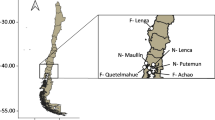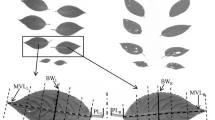Abstract
Micropopulation differences in phenol content between intertidal and subtidal individuals of the kelp Lessonia nigrescens were found. Subtidal plants showed: (1) significantly higher phenol content than intertidal individuals, in vegetative and reproductive tissues, (2) intra-plant differences, with higher content in apical frond tissues, (3) higher resistance to consumption by herbivorous fishes. The microscopic progeny of subtidal plants showed the same trend as adult plants: (1) haploid spores from subtidal plants had higher phenol content than spores from intertidal individuals, and (2) the microscopic sporophytes derived from subtidal spores and gametophytes were less consumed by herbivorous snails (Tegula tridentata) than those derived from intertidal plant propagules. No increase in phenol content was detected after mechanical injury to experimental fronds, or after transplantation to the subtidal environment.
In addition to the absence of inducible responses, the different phenol content between intertidal and subtidal individuals, in adult diploid plants and also in the haploid progeny, suggests that both environments differ someway enough to fix the mentioned features on the plants of Lessonia nigrescens. It is likely that the differences in herbivory between the two distributional extremes contributed to the observed pattern.
Similar content being viewed by others
References
Anderson, E. K. & W. J. North, 1966. In situ studies of spore production and dispersal in the giant kelp, Macrocystis. Proc. Int. Seaweed Symp. 5: 73–86.
Cáceres, C. W., L. S. Fuentes & F. P. Ojeda, 1994. Optimal feeding strategies of the temperate herbivorous fish Aplodactylus punctatus: the effect of food availability on digestive and reproductive patterns. Oecologia 99: 118–123.
Camus, P. A. & E. A. Martínez, 1994. The exploitation of brown algae in Chile. Appl. Phycol. Forum 11: 4–5.
Denton, A. B. & A. R. O. Chapman, 1991. Feeding preferences of gammarids amphipods among four species of Fucus. Mar. Biol. 109: 503–506.
Estes, J. A. & P. D. Steinberg, 1988. Predation, herbivory and kelp evolution. Paleobiology 14: 19–36.
Hay, M. E. & W. Fenical, 1988. Marine plant-herbivore interactions: the ecology of chemical defense. Ann. Rev. Ecol. Syst. 19: 111–145.
Himmelman, J. H. & H. Nédélec, 1990. Urchin foraging and algal survival strategies in intensely grazed communities in eastern canada. Can. J. Fish. aquatic Sci. 47: 1011–1026.
Johnson, C. R. & K. H. Mann, 1986. The importance of plant defence abilities to the structure of subtidal seaweed communities: the kelp Laminaria longicruris de la Pylaie survives grazing by the snail Lacuna vincia (Montagu) at high population densities. J. exp. mar. Biol. Ecol. 97: 231–267.
Kendrick, G. A. & D. Walker, 1991. Dispersal distances for propagules of Sargassum spinuligerum (Sargassaceae, Phaeophyta) measured directly by vital staining and venturi suction sampling. Mar. Ecol. Progr. Ser. 79: 133–138.
Newbegin, E., M. A. Anderson & A. E. Clarke, 1993. Gametophytic self incompatibility systems. Plant Cell 5: 1315–1324.
Ragan, M. A., 1976. Physodes and the phenolic compounds of brown algae. Composition and significance of physodes in vivo. Bot. mar. 19: 145–154.
Ragan, M. A., 1984. The high molecular weight polyphloroglucinols of the marine brown alga Fucus vesiculosus L.: degradative analysis. Can. J. Chem. 63: 294–303.
Ragan, M. A., 1985. Brown algal polyphenols: synthesis of ‘fucoflorethol A’ octamethyl ether (2,2′,4,6,6′-pentamethoxy-4′-(2,4,6trimethoxyphenoxy)biphenyl). Can. J. Chem. 63: 291–293.
Ragan, M. A. & A. Jensen, 1977. Quantitative studies on brown algal phenols. I. Estimation of absolute polyphenol content of Ascophyllum nodosum (L.) Le Jol. and Fucus vesiculosus (L.). J. exp. mar. Biol. Ecol. 30: 209–221.
Ragan, M. A. & A. Jensen, 1978. Quantitative studies on brown algal phenols. II. Seasonal variation in polyphenol content of Ascophyllum nodosum (L.) Le Jol. and Fucus vesiculosus (L.). J. exp. mar. Biol. Ecol. 34: 245–258.
Ragan, M. A. & A. Jensen, 1979. Quantitative studies on brown algal phenols. III. Light-mediated exudation of polyphenols from Ascophyllum nodosum (I.) Le Jol. J. exp. mar. Biol. Ecol. 36: 91–101.
Ragan, M. A. & W. D. Jamieson, 1982. Oligomeric polyphloroglucinols from Fucus vesiculosus: photoplate mass spectrometric investigation. Phytochem. 21: 2709–2711.
Ragan, M. A., C. M. Ragan & A. Jensen, 1980. Natural chelators in sea water: detoxification of Zn2+ by brown algal polyphenols. J. exp. mar. Biol. Ecol. 44: 261–267.
Ramírez, M. E. & B. Santelices, 1991. Catálogo de las algas marinas de la costa temperada del Pacífico de Sudamérica. Publicaciones Periódicas, Pontificia Universidad Católica de Chile, Vicerrectoría Académica. Monografías Biológicas 5: 1–437.
Reed, D. C., D. R. Laur & A. W. Ebeling, 1988. Variation in algal dispersal and recruitment: the importance of episodic events. Ecol. Monogr. 58: 321–335.
Reed, D. C., M. Neushul & A. W. Ebeling, 1991. Role of settlement density on gametophytic growth and reproduction in the kelps Pterygophora californica and Macrocystis pyrifera (Phaeophyceae). J. Phycol. 27: 361–366.
Santelices, B. & F. P. Ojeda, 1984. Recruitment, growth and survival of Lessonia nigrescens (Phaeophyta) at various tidal levels in exposed habitats of central Chile. Mar. Ecol. Progr. Ser. 19: 73–82.
Sieburth, J. M. & J. T. Conover, 1965. Sargassum tannin and antibiotic which retards fouling. Nature 208: 52–53.
Sideman, E. J. & A. C. Mathieson, 1983. Ecological and genecological distinctions of a high intertidal dwarf form of Fucus distichus (L.) Powell in New England. J. exp. mar. Biol. Ecol. 72: 171–188.
Statgraphics, 1988. Statistical Graphics System. Statistical Graphics Corporation. STSC, Inc.
Steinberg, P. D., 1985. Feeding preferences of Tegula funebralis and chemical defenses of marine brown algae. Ecol. Monogr. 55: 333–349.
Steinberg, P. D. 1988. Effects of quantitative and qualitative variation in phenolic compounds on feeding of three species of marine invertebrates herbivores. J. exp. mar. Biol. Ecol. 120: 221–237.
Steinberg, P. D. & I. van Altena, 1992. Tolerance of marine invertebrate herbivores to brown algal phlorotannins in temperate Australasia. Ecol. Monogr. 62: 189–222.
Targett, N. M., L. D. Coen, A. A. Boettcher & C. E. Tanner, 1992. Biogeographic comparisons of brown algal polyphenolics: evidence against a latitudinal trend. Oecologia 89: 464–470.
Vadas, R. L. 1977. Preferential feeding: an optimization strategy in sea urchins. Ecol. Monogr. 337–371.
van Alstyne, K. L., 1988. Herbivore grazing increases polyphenolic defenses in the intertidal brown alga Fucus distichus. Ecol. 69: 655–663.
van Alstyne, K. L., 1989. Adventitious branching as a herbivore-induced defense in the intertidal brown alga Fucus distichus. Mar. Ecol. Progr. Ser. 56: 169–176.
van Alstyne, K. L. & V. J. Paul, 1990. The biogeography of polyphenolic compounds in marine macroalgae: temperate brown algal defenses deter feeding by tropical herbivorous fishes. Oecologia 84: 158–163.
Winter, F. C. & J. A. Estes, 1992. Experimental evidence for the effects of phenolic compounds from Dictyoneurum califbrnicum Ruprecht (Phaeophyta, Laaminariales) on feeding rate and growth in the abalone Haliotis rufescens Swaison. J. exp. mar. Biol. Ecol. 155: 263–277.
Author information
Authors and Affiliations
Rights and permissions
About this article
Cite this article
Martínez, E.A. Micropopulation differentiation in phenol content and susceptibility to herbivory in the Chilean kelp Lessonia nigrescenss (Phaeophyta, Laminariales). Hydrobiologia 326, 205–211 (1996). https://doi.org/10.1007/BF00047808
Issue Date:
DOI: https://doi.org/10.1007/BF00047808




